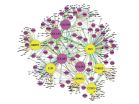(Press-News.org) PITTSBURGH—It's commonly believed that creativity is a process that involves connecting ideas and building on the past to create something new. But is it better to "think outside the box," using unrelated concepts to get the creative juices flowing, or to build on something more closely related to the problem one is trying to solve?
In a paper newly published in Design Studies, recent University of Pittsburgh graduate Joel Chan and his mentor Christian Schunn of Pitt's Learning Research and Development Center, along with Carnegie Mellon University's Steven Dow, have collected surprising evidence that nearer is better.
"For people needing fresh inspiration for a problem, these findings imply that you shouldn't just go off and talk to random people or read things totally unrelated to your problem," says Chan, the lead author, who earned his PhD from Pitt this summer and is now a postdoctoral fellow in Carnegie Mellon's Human-Computer Interaction Institute. "These might yield novel ideas, but not necessarily ... useful and novel ideas."
Chan and Schunn, professor of psychology and senior scientist at Pitt's Learning Research and Development Center, collected data through OpenIDEO, a web-based crowdsourced innovation platform intended to help people address a wide range of social and environmental problems like human rights violations and job growth for youth.
The team began collecting data from OpenIDEO's "inspiration phase," during which individuals posted descriptions of solutions to problems similar to those posited by new solution seekers. Subsequent to the "inspiration phase," contributors moved on to posting more concrete, increasingly detailed solutions to the specific problem at hand. Then, OpenIDEO experts created a shortlist of what they saw to be viable creative solutions to the problem. The process took up to 10 weeks. Other similar studies, Chan says, have looked at the creative process over a much shorter period of time. Also, he adds, "in our study we had more than 350 participants and thousands of ideas. Creativity studies typically have many participants solve 'toy' problems or observe few participants solving real problems—in our study we had both, lending greater strength to our conclusions."
The team collected its data at the conclusion of the OpenIDEO process. They then entered it into an algorithm to determine whether an idea was near to or far from the posted problem. This algorithm was first vetted against human judgments and proved to be quite good at determining idea distance. Then, the outcomes of the model proved adept at predicting the OpenIDEO experts' shortlist and found that the vast majority of ideas that made the list were closely related to the posted problem, Schunn says.
"Instead of seeing a bigger effect of far inspirations," Chan says, "I saw that ideas built on source ideas more closely related to the problem tended to be selected more often. And I saw the same pattern across 12 very different problems—ranging from preventing human rights violations to fostering greater connectedness in urban communities to improving employment prospects for young people."
Schunn adds that "we chose to look at a variety of problems to find out if there is a consistent pattern, and there is. And we can use this algorithm as a tool for a variety of problems, to identify the ideas that are 'close' and direct people to look at them."
In short, Chan says, "My overall theory is that creative ideas more often come from accumulating many small insights, stretching the boundaries just a bit at a time."
INFORMATION: END
Where'd you get that great idea?
Pitt team seeks the source of creativity: Near or far?
2014-11-04
ELSE PRESS RELEASES FROM THIS DATE:
NASA's Aqua satellite sees Hurricane Vance headed for landfall in western Mexico
2014-11-04
NASA's Aqua satellite passed over Vance on Nov. 3 as it started moving in a northeasterly direction toward the northwestern coast of Mexico. On Nov. 4, a Tropical Storm Watch was in effect from Mazatlan northward to Topolobampo, Mexico. Hurricane Vance is forecast to make landfall in northwestern mainland Mexico on Nov. 5.
On Nov. 3 at 20:50 UTC (3:50 p.m. EST) the Moderate Resolution Imaging Spectroradiometer or MODIS instrument that flies aboard NASA's Aqua satellite captured a visible image of Hurricane Vance off Mexico's west coast. The eastern quadrant of the storm ...
Why does red meat increase the risk for cardiovascular disease? Blame our gut bacteria
2014-11-04
New research provides details on how gut bacteria turn a nutrient found in red meat into metabolites that increase the risk of developing heart disease. Publishing in the November 4th issue of the Cell Press journal Cell Metabolism, the findings may lead to new strategies for safeguarding individuals' cardiovascular health.
Previous research led by Dr. Stanley Hazen, of Lerner Research Institute and the Miller Family Heart and Vascular Institute at Cleveland Clinic, revealed a pathway by which red meat can promote atherosclerosis, or hardening of the arteries. Essentially, ...
Granger causality test can make epilepsy surgery more effective
2014-11-04
ATLANTA—A new statistical test that looks at the patterns of high-frequency network activity flow from brain signals can help doctors pinpoint the exact location of seizures occurring in the brain and make surgery more effective, according to researchers at Georgia State University and Emory University School of Medicine. The findings are published in the journal Epilepsia.
Emory researchers Dr. Charles Epstein, Dr. Robert Gross and Dr. Jon Willie; Dr. Bhim Adhikari, a post doctoral researcher at Georgia State, and Dr. Mukesh Dhamala, an associate professor of ...
Mayo Clinic researchers discover genetic markers for alcoholism recovery
2014-11-04
ROCHESTER, Minn. — In an international study, Mayo Clinic researchers and collaborators have identified genetic markers that may help in identifying individuals who could benefit from the alcoholism treatment drug acamprosate. The findings, published in the journal Translational Psychiatry, show that patients carrying these genetic variants have longer periods of abstinence during the first three months of acamprosate treatment.
Acamprosate is a commonly prescribed drug used to aid patients in recovery from alcoholism. Mayo researchers studied the association between ...
Are there as many rats as people in New York City?
2014-11-04
Urban legend states that New York City has as many rats as people: roughly 8 million; but a new analysis suggests there are nowhere near as many.
The analysis classified rat sightings by city lot, of which there are roughly 842,000 in New York City. The researchers estimated 40,500 rat-inhabited lots in the city. By liberally assuming that 40 to 50 rats belong to a typical colony and that one full colony occupies each rat-inhabited lot, the researchers concluded that 2 million would be an extremely generous estimate of the city's rat population.
"While the rat population ...
Type 2 diabetes, cardiovascular disease may share deep roots
2014-11-04
PROVIDENCE, R.I. [Brown University] — Type 2 diabetes (T2D) and cardiovascular disease (CVD) appear to have a lot in common. They share risk factors such as obesity and they often occur together. If they also share the same genetic underpinings, then doctors could devise a way to treat them together too. With that hope in mind, scientists applied multiple layers of analysis to the genomics of more than 15,000 women. In a new study they report finding eight molecular pathways shared in both diseases as well as several "key driver" genes that appear to orchestrate the ...
Research in the identity of agricultural pests has broad implications
2014-11-04
A global research effort has resolved a major biosecurity issue by determining that four of the world's most destructive agricultural pests are one and the same.
The Oriental fruit fly, the Philippine fruit fly, the Invasive fruit fly, the Carambola fruit fly, and the Asian Papaya fruit fly cause incalculable damage to horticultural industries and food security across Asia, Africa, the Pacific, and parts of South America. More than 40 researchers from 20 countries examined available evidence and determined that the Carambola fruit fly is a distinct species, but the other ...
Many future health professionals drink too much alcohol
2014-11-04
A new study found that 43% of nursing students indulge in hazardous alcohol consumption, with 14.9% of men and 18.7% of women meeting criteria for hazardous drinkers.
Hazardous drinkers were more likely to be young, to smoke, and to live outside the family nucleus.
"Alcohol-prevention activities should envisage greater protection of university settings, particularly where future health professionals are involved," wrote the authors of the Journal of Advanced Nursing study.
INFORMATION:
...
New research explores scent communication in polar bears
2014-11-04
New research indicates that scent associated with polar bear paws conveys information that may affect the animals' social and reproductive behavior. This chemical form of communication was likely shaped by the environmental constraints of Arctic sea ice.
Scientists worry that this communication may be impacted if scent trails are disrupted due to increased fracturing of sea ice from climate change.
"Effective communication is essential for successful reproduction in solitary, wide-ranging animals," said Dr. Megan Owen, lead author of the Journal of Zoology study. "Developing ...
Syracuse geologist reveals correlation between earthquakes, landslides
2014-11-04
A geologist in Syracuse University's College of Arts and Sciences has demonstrated that earthquakes--not climate change, as previously thought--affect the rate of landslides in Peru.
The finding is the subject of an article in Nature Geoscience (Nature Publishing Group, 2014) by Devin McPhillips, a research associate in the Department of Earth Sciences. He co-wrote the article with Paul Bierman, professor of geology at The University of Vermont; and Dylan Rood, a lecturer at Imperial College London (U.K.).
"Geologic records of landslide activity offer rare glimpses ...
LAST 30 PRESS RELEASES:
Chonnam National University researchers propose innovative voltage-loop control for power factor correction
Accelerating next-generation drug discovery with click-based construction of PROTACs
Detecting the hidden magnetism of altermagnets
$7M gift supports health research, engineering and athletics at UT San Antonio
NU-9 halts Alzheimer’s disease in animal model before symptoms begin
Hospitals acquired by real estate investment trusts associated with greater risk of bankruptcy, closure
City of Hope scientists study rare disorder to uncover mechanism and hormone regulation underlying fatty liver disease and sweet aversion
Your genes may influence gut microbiome of others, rat study shows
‘Personality test’ shows how AI chatbots mimic human traits – and how they can be manipulated
Global food systems driving twin crises of obesity and global heating
Osaka Medical and Pharmaceutical University researchers capture real-time molecular movies of enzyme catalysis
Could your genes influence the gut microbiome of others?
Clues to Alzheimer’s disease may be hiding in our ‘junk’ DNA
Study reveals that the body uses different sensors to detect cold in the skin and in internal organs
iPS cells from dish to freezer and back
Deep neural networks enable accurate pricing of American options under stochastic volatility
Collective risk resonance in Chinese stock sectors uncovered through higher-order network analysis
Does CPU impact systemic risk contributions of Chinese sectors? Evidence from mixed frequency methods with asymmetric tail long memory
General intelligence framework to predict virus adaptation based on a genome language model
Antibiotic resistance is ancient, ecological, and deeply connected to human activity, new review shows
Vapes, pouches, heated tobacco, shisha, cigarettes: nicotine in all forms is toxic to the heart and blood vessels
From powder to planet: University of Modena engineers forge a low-carbon future for advanced metal manufacturing
Super strain-resistant superconductors
Pre-school health programme does not improve children’s diet or physical activity, prompting call for policy changes, study finds
Autumn clock change linked to reduction in certain health conditions
AI images of doctors can exaggerate and reinforce existing stereotypes
Where medicine meets melody – how lullabies help babies and parents in intensive care
We may never be able to tell if AI becomes conscious, argues philosopher
AI video translation shows promise but humans still hold the edge
Deep ocean earthquakes drive Southern Ocean’s massive phytoplankton blooms, study finds
[Press-News.org] Where'd you get that great idea?Pitt team seeks the source of creativity: Near or far?


